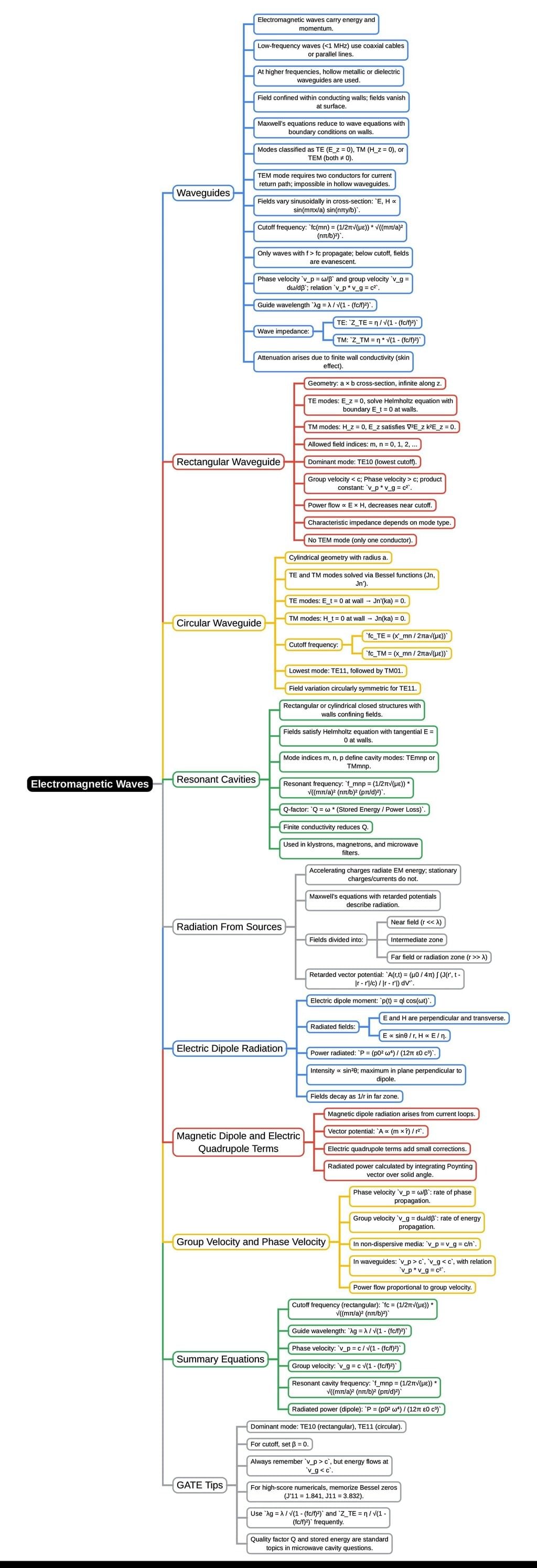Electronics and Communication Engineering (ECE) Exam > Electronics and Communication Engineering (ECE) Notes > Electromagnetics > Mind Map: Electromagnetic Waves
Mind Map: Electromagnetic Waves | Electromagnetics - Electronics and Communication Engineering (ECE) PDF Download

The document Mind Map: Electromagnetic Waves | Electromagnetics - Electronics and Communication Engineering (ECE) is a part of the Electronics and Communication Engineering (ECE) Course Electromagnetics.
All you need of Electronics and Communication Engineering (ECE) at this link: Electronics and Communication Engineering (ECE)
|
11 videos|94 docs|89 tests
|
FAQs on Mind Map: Electromagnetic Waves - Electromagnetics - Electronics and Communication Engineering (ECE)
| 1. What are electromagnetic waves and how are they classified? |  |
Ans.Electromagnetic waves are waves that propagate through space and carry electromagnetic radiant energy. They are classified into several categories based on their frequency and wavelength, which include radio waves, microwaves, infrared, visible light, ultraviolet, X-rays, and gamma rays. The electromagnetic spectrum encompasses all these types, with radio waves having the longest wavelengths and gamma rays having the shortest.
| 2. What is the significance of Maxwell's equations in understanding electromagnetic waves? |  |
Ans.Maxwell's equations are a set of four fundamental equations that describe how electric and magnetic fields interact and propagate. They provide the theoretical foundation for understanding electromagnetic waves. These equations show that a changing electric field generates a magnetic field and vice versa, leading to the propagation of electromagnetic waves through space. This framework is essential in fields like electronics and communication engineering.
| 3. How do electromagnetic waves propagate through different mediums? |  |
Ans.Electromagnetic waves can propagate through a vacuum, air, and various materials, but the speed and behavior of the waves change depending on the medium. In a vacuum, electromagnetic waves travel at their maximum speed, the speed of light (approximately 3 × 10⁸ m/s). When they enter a denser medium, like glass or water, their speed decreases, and they may bend due to refraction. The degree of bending depends on the refractive index of the medium.
| 4. What are some practical applications of electromagnetic waves in communication engineering? |  |
Ans.Electromagnetic waves play a crucial role in various communication technologies. They are used in radio and television broadcasting, mobile phone communications, satellite communications, and wireless networking (such as Wi-Fi). Additionally, different frequencies of electromagnetic waves are utilized for radar systems, remote sensing, and medical imaging technologies, highlighting their versatility in modern communication systems.
| 5. What is the relationship between frequency, wavelength, and energy in electromagnetic waves? |  |
Ans.The energy of an electromagnetic wave is directly proportional to its frequency and inversely proportional to its wavelength. This relationship can be expressed using the formula E = hν, where E is energy, h is Planck's constant, and ν is frequency. Consequently, waves with higher frequencies (such as X-rays) have shorter wavelengths and higher energy, while waves with lower frequencies (like radio waves) have longer wavelengths and lower energy.
Related Searches















